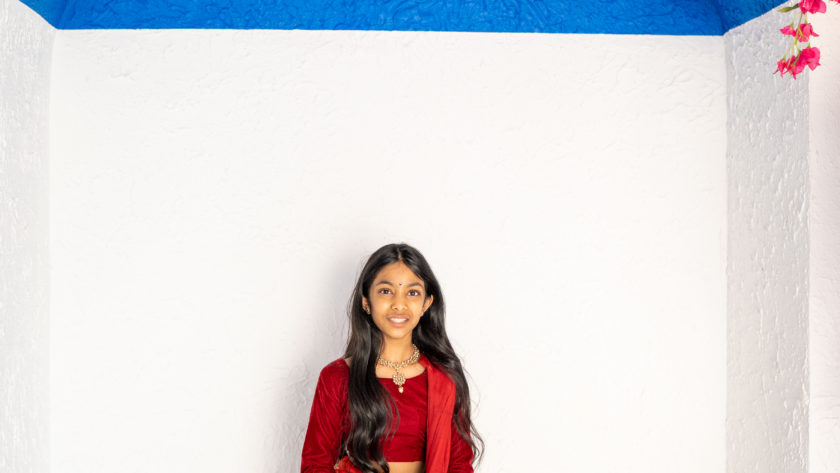Recently the lovely Shots by Shiro captured this beautiful shot of Akshaya as part of her 10th birthday portrait session. When I shared this particular photo with my family and friends, they all commented on how much she’s grown in the past year. As much as I still think of her as my baby, the reality is that within the next couple years my eldest will be approaching puberty and if you’re part of the Tamil community you probably know where this post is headed. The Samithya Veedu or coming of age celebration is a celebration that marks the arrival of a girl’s first period. Perhaps not so surprisingly, Tamils weren’t the only ones to hold coming of age ceremonies. These ceremonies have been predominant throughout the world in many different cultures; Of the more popular ones are the Latin America’s Quinceanera, the Jewish Bat and Bar Mitzvah, the Amish Rumspringa, and Native American Apache Tribe’s sunrise ceremony which like the Tamil Samithya Veedu celebrates the girl’s first period. In recent years this Tamil celebration has become quite the controversial topic amongst modern-day parents as they argue whether the starting of a girl’s period needs to be publicly announced to family and friends and celebrated.
Historically the Samithya Veedu was a celebration of fertility but also a way that households announced to those in the village and possibly beyond that their daughter would be soon eligible for marriage. This was done at a time where girls usually got their periods at 14-17 years old and married a lot earlier than they do now. It gave relatives ample time and opportunity to find a suitable groom for when the girl was ready for marriage at a period in time where arranged marriages based on astrological charts were common and at a time where people didn’t have the advantage of telephones and Internet for communication. However, in the modern world, girls are attaining puberty much, much earlier than their ancestors did and marrying a lot later, if they choose to do so at all. In light of this, the purpose of a Samithya Veedu has evolved over the years to be more of a commercial celebration showcasing wealth with elegant invitations, the rental of party halls, videographers, a cake-cutting, speeches, and even entertainment for a large number of guests which often include acquaintances. Usually these celebrations take place months or years after the girl has attained her first period in an attempt to find a more convenient time or save up and prepare for bigger and better, defeating the purpose of why it’s celebrated in the first place.
In Tamil Hindu culture, many events in a child’s life are celebrated as a means of cleansing the negative energy that may be caused by planetary influences at the time that milestone is reached thereby ensuring all critical stages of life are welcomed with good energy. We celebrate the first month of life, the first visit to temple (traditionally the first time child leaves the home after birth and sees the sun), the first bite of solid food, the first tooth, ear piercing, a child’s first letters which initiates education, and more. The first period is celebrated just like any of the aforementioned milestones. In ancient times boys had sort of an equivalent; a coming of age celebration which signaled that they were ready to start learning the Vedas (this is not something the majority do now and thus got scrapped with time).
When a girl got her first period, our ancestors kept them to the home for the first 5-7 days for rest until the bleeding ceased. They used neem leaves and turmeric, both which possess antibacterial elements, in addition to various medicinal plants and flowers. They used mango leaves at the entrance of homes to increase oxygen in the home. They fed the child sesame seed oil, special spices, herbs, and foods to help increase iron levels, control the flow, and strengthen the womb. Once the girl stopped bleeding, a cleansing ceremony to dispel negative planetary influences and invoke blessings would be performed. The girl would be adorned in the traditional saree in an auspicious colour for the first time, adorned in gifts of gold with the belief that gold attracts positive energy and is good for reproductive health, and given the opportunity to light the auspicious villaku (oil lamp of the home) signifying her new status as a woman within her family. The women in the family, in pairs, performed a ritual called an aalathi to bless the girl on her coming of age and fertility.
Although this part of the traditional ceremony continues to be central to celebrations today, through time, war, and relocation, a lot of the true purpose and knowledge has been lost. A thoughtful celebration of womanhood has been turned into either something of status with minimal religious meaning or something to be embarrassed of. I’ve thought long and hard about what I’d like to do for my own daughters, and like all celebrations I’ve celebrated on behalf of my children in par with our heritage, I would like to celebrate their Samithya Veedu when their time comes with their consent. But I will choose to do it in the traditional sense, at home, with only the people closely involved in her life in a very intimate ceremony. In a world that still faces period shame, I’d like to believe celebrations like this will present as opportunities to educate and normalize periods and thus remove the stigma surrounding menstruating girls and women. I have faith that my ancestors had it right before the patriarchy influenced the people, in that periods are nothing to be ashamed of, and rather something to be celebrated, as without it the human race will cease to exist.
Now that I’ve shared my thoughts, I’d love to hear yours in regards to this ancient Tamil celebration, back over on my Instagram post. All opinions are welcome but please remember to keep them respectful.
NOTE:
Whether you choose to have a Samithya Veedu for your daughter or not, don’t forget to have conversations about not only periods but other changes that happen with puberty, their biological significance, feminine hygiene products, hygiene practices, healthy eating, and more to ensure that your daughter has the best experience possible once her time comes.




Hi Geerthana,
I bumped into your article while searching for viratham methods for puratasi sani. While browsing your page, this article caught my eye. I absolutely agree with all that you have mentioned, mainly that we need to understand the meaning behind the rituals our ancestors have passed to us and their significance. I am often explaining to my friends the importance behind the traditions of samithiya veedu and how simple it can be done at home when you take extravagance out of the equation and put the celebration of this milestone at the center. This is a beautifully explained piece. 🙂 Thank you.